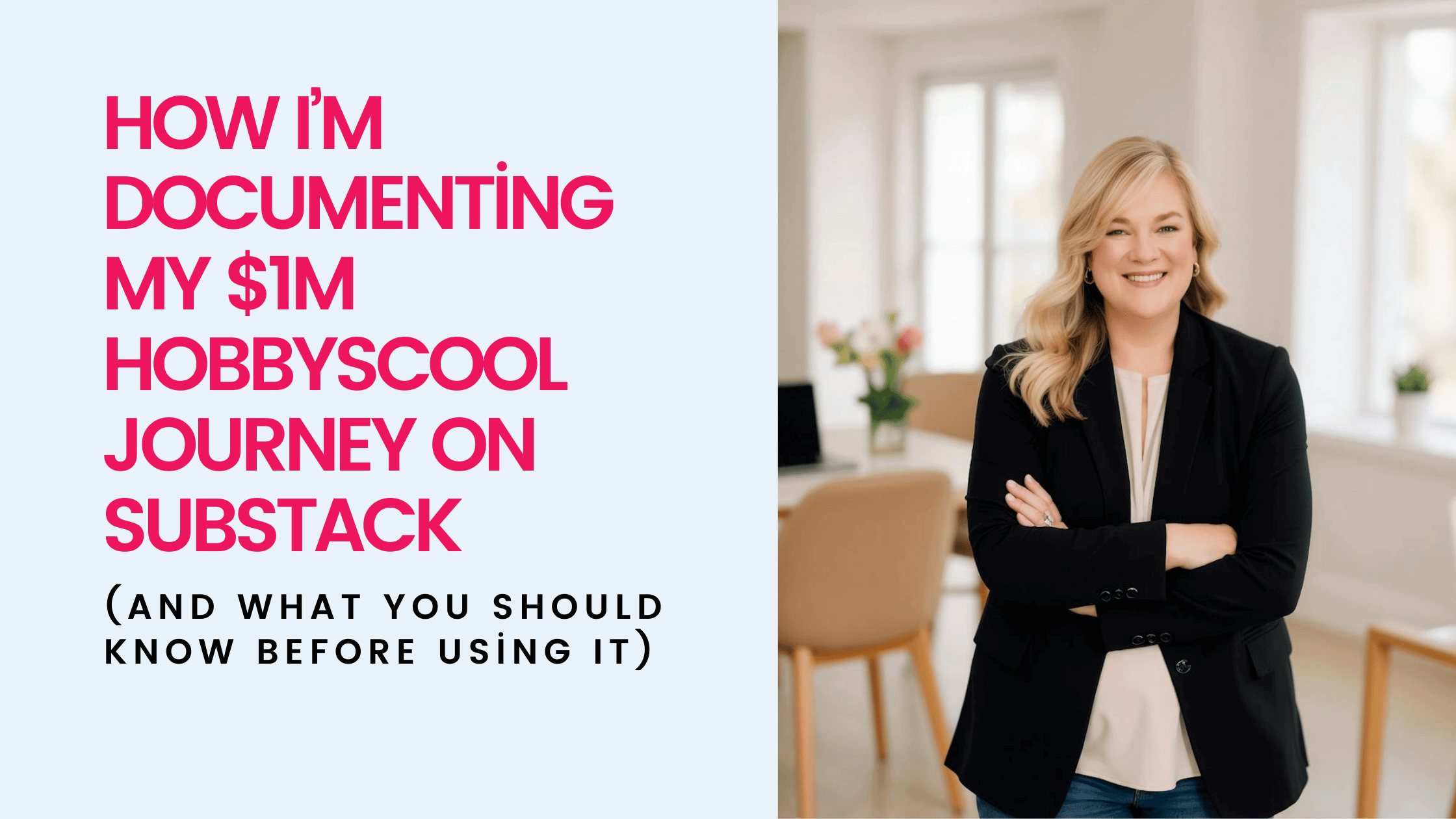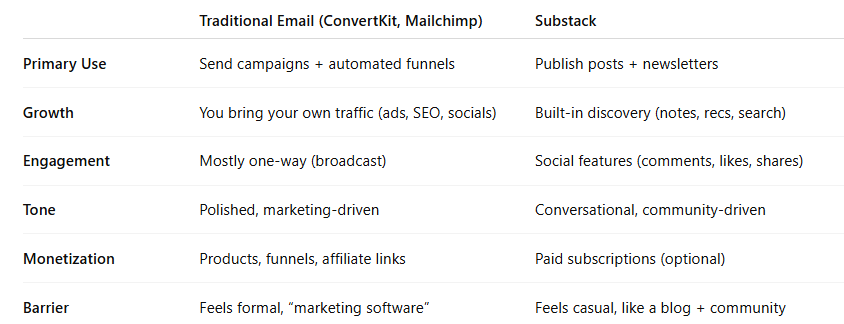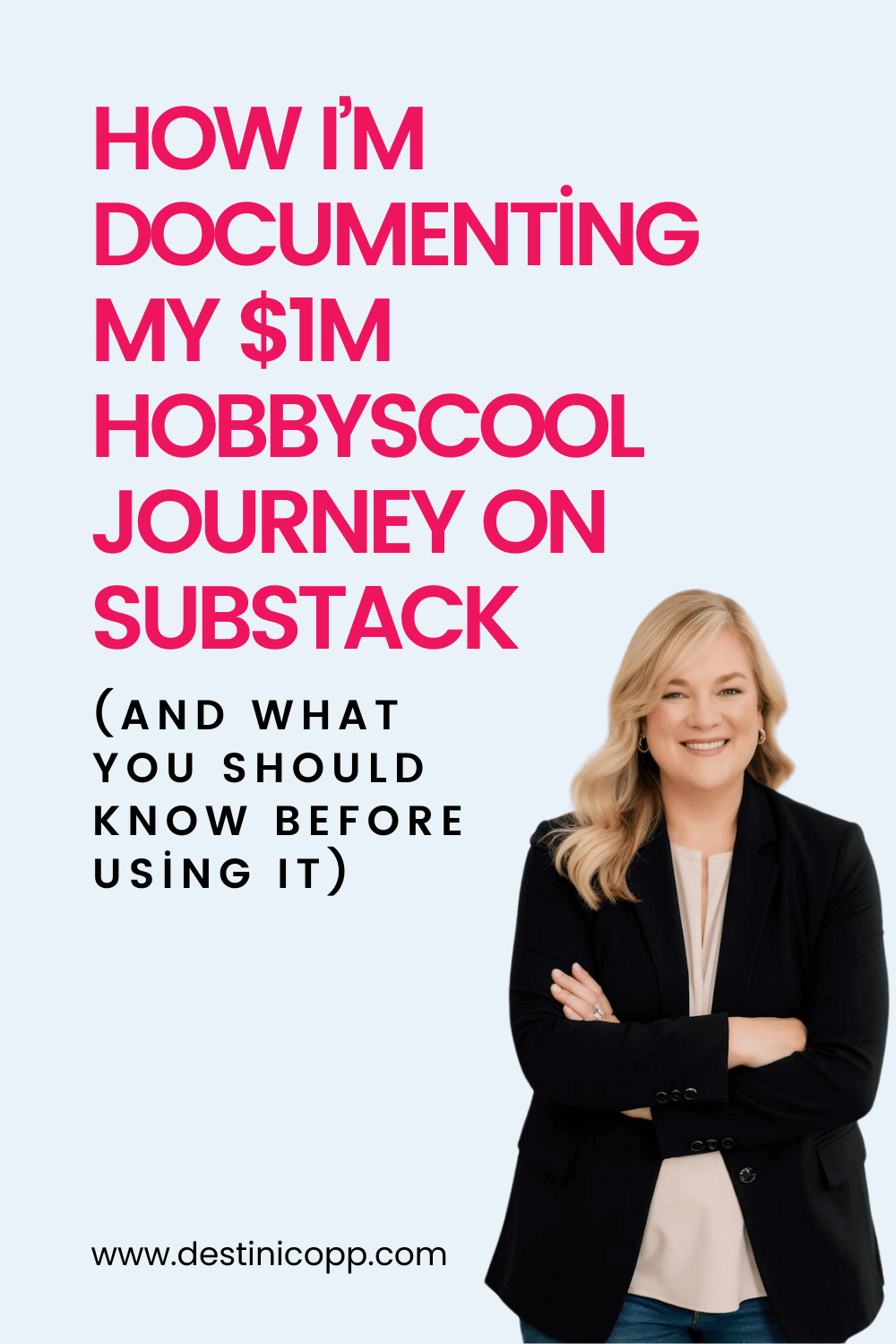237: How I’m Documenting My $1M HobbyScool Journey on Substack (And What You Should Know Before Using It)
Have you ever wanted to document your journey in real-time, but struggled to find the right platform to do it?
Instead of hiding the process in spreadsheets or behind-the-scenes Google docs documents, I chose to build in public and Substack was the perfect home for it.
In this episode, I’m taking you behind the scenes of my new experiment: using Substack not only to document my business journey, but also to explore whether it can be a real discovery and visibility engine for entrepreneurs.
I’ll walk you through why I chose Substack over other platforms, how it compares to traditional email service providers, and what I’m actually sharing in my paid behind-the-scenes newsletter.
Whether you’re Substack-curious or just want a better way to connect with your audience, this episode gives you a real-world case study in action.
What You’ll Learn:
Why I started the $1M HobbyScool experiment and chose to document it publicly
The two-part reason I decided Substack was the perfect platform for this journey
How Substack differs from tools like Kit, ActiveCampaign, and Flowdesk
What I’m sharing inside my paid Substack newsletter (hint: it’s the messy middle)
The truth about Substack’s content guidelines—and what that means for your offers
How to use Substack without replacing your email provider
My key takeaways if you’re thinking about using Substack for your business
If you’re wondering how Substack might fit into your business or how to share more of your real-time journey without burning out, I think you’ll love this conversation.
Click play to listen, and if you want to peek behind the scenes, check out the free trial to my Substack below!
Mentioned in this episode:
Subscribe to my Substack for free here to follow along.
And if you want the full unfiltered story — including the financials — join the paid version right here.
Thinking About Substack? Here’s What You Really Need to Know
If you’ve ever thought about building something big and bold and wanted a way to share the messy middle in real time—you’re not alone. When I set the goal to grow HobbyScool into a $1M sellable brand by the end of 2027, I knew I didn’t want to keep that journey hidden away in spreadsheets and private notes.
Instead, I made a strategic choice: I’m documenting everything, wins, pivots, mistakes, and real numbers, on Substack.
Not because Substack is where I’m building HobbyScool. But because it’s the perfect platform for sharing the journey. And in today’s post, I want to walk you through exactly why I chose Substack, what I’ve learned so far, and what you need to know before you start using it for your business.
Why Substack (and Not My ESP, Google Docs, or a Funnel)?
Let’s start here: I didn’t move my newsletter list to Substack. I still run all of my core email marketing—sales funnels, automations, launches—through Kit. That’s the engine of my business. But I knew I needed something different for this behind-the-scenes project.
I first thought about using a Google Doc or even turning it into a private paid membership. But those options felt...invisible. They lacked organic reach, and I’d have to work extra hard just to get eyes on them. Plus, they didn’t offer that community-driven, conversational vibe I was looking for.
Substack, on the other hand, felt like the perfect lab.
Every post is automatically emailed to subscribers
Each post lives on your Substack site like a blog—searchable and shareable
The platform has built-in discovery through “Notes” and recommendations
You can offer paid subscriptions and build a monetized newsletter community
And most importantly: it feels natural, human, and real-time
That’s exactly what I needed to share the story of building HobbyScool into something big.
What I’m Actually Sharing Inside My Substack
The free posts on Substack are where I tell the broader story. But the real magic happens inside the paid newsletter.
Subscribers get access to:
Revenue snapshots and real numbers
Business pivots (including what flopped and why)
Decisions I’m making in real time
Things that don’t make it into polished case studies
Lessons from messy middles and behind-the-scenes experiments
I’ve always wanted to create a live case study, and this is it—only it’s happening in public, and you can follow along in real time.
And yes, I’m charging for it. Because the unfiltered, unpolished journey? It’s valuable. It’s something most people only share after the fact. I wanted to invite people into the process now, while I’m still building.
Substack vs. Email Service Providers (There’s a Big Difference)
One of the biggest misconceptions I see is this: people think Substack can replace their email service provider.
It can’t. And it shouldn’t.
Your ESP (like Kit, ActiveCampaign, or Flowdesk) is your business backbone. It’s where your automation lives. It’s how you sell products and run your marketing. Substack is different.
Here’s what I’ve learned about the difference between Substack and traditional email service providers:
They’re not in competition—they’re complementary.
Substack is a discovery engine. It’s a community platform. It’s storytelling-first, not sales-first. That distinction matters, especially if you're planning to use both in your business.
A Word of Caution: Substack’s Terms Matter
When I first dove into Substack, I did what I always do—I read the fine print. And I found something important:
Substack does not allow publications whose primary purpose is to advertise external products or drive traffic off-platform.
Now, that phrase “primary purpose” is vague. But if all you’re doing is publishing affiliate links, pushing digital product sales, or linking to outside funnels—you could get flagged.
That’s why I’m using Substack strategically:
I promote only my paid Substack newsletter
I treat it as a content channel, not a marketing funnel
I focus on visibility, not conversions
That’s what keeps it aligned with Substack’s guidelines and keeps it effective for me and my readers.
Should You Use Substack? Here’s My Take
Substack won’t be right for everyone. But if you’re:
Craving a way to document your journey in real time
Wanting more visibility without relying on algorithms
Interested in community building
Looking for a clean, simple, writer-friendly platform
…it might be the perfect fit.
Just don’t move your entire list or funnels over. Keep your ESP. Use Substack alongside your existing tools. Treat it like a content layer—not your whole business.
That mindset shift makes all the difference.
Final Thoughts
For me, Substack is the perfect place to share the real-time, messy, and meaningful journey of building HobbyScool into a $1M brand. It’s where I can connect directly with people, have real conversations, and show what it actually takes to build something from scratch.
If you want to follow along, I’d love to have you. You can check out the newsletter, get access to the paid posts, and even grab a one-month free trial at here.
Pin this and save for later
Transcript:
[00:01:00] Introducing the $1M HobbyScool Experiment
Hey friends, Destini here. Today’s episode is a little different. I want to take you behind the scenes of a personal project I’ve been working on—one that combines two of my favorite things: experimenting and storytelling.
I’ve set a big goal for myself: to grow HobbyScool into a $1 million sellable brand by the end of 2027. But instead of keeping this journey buried in spreadsheets or Google Docs, I’m documenting it publicly—on Substack.
[00:02:00] Why Substack? The Two-Part Experiment
This is really two experiments in one:
Exploring Substack as a platform—because I get asked about it all the time inside my Profit Club.
Documenting the HobbyScool journey in real-time.
I didn’t want to guess how Substack worked—I wanted to use it firsthand so I could give real, honest feedback.
[00:03:00] Why Substack Just Clicked
I looked at all the options: Google Docs, private back-end memberships, even social platforms. But Substack felt different—more like a lab.
It’s community-driven.
It’s searchable and shareable.
It allows paid subscriptions.
It felt like the perfect place to document the “messy middle” of building a business.
[00:04:00] Substack Basics (For the Unfamiliar)
Substack started as a newsletter platform, but now it’s so much more. Every post gets emailed to your list and also lives on your Substack site like a blog. You can be discovered through built-in features like “Notes,” and you can turn on monetization through paid subscriptions, just like I’ve done.
[00:05:00] Why I Didn’t Choose Other Tools
Google Docs are invisible unless I promote them. Instagram is algorithm-driven and ephemeral. My email service provider (ESP) and ThriveCart could’ve worked, but they’d require heavy funnel building.
Substack felt more natural. It’s conversational, easy to use, and allowed me to share openly—with no fancy funnels.
[00:07:00] What I Share in My Paid Newsletter
In my paid Substack, I share:
Revenue snapshots
Real numbers
Pivots and flops
The unpolished decisions most people hide
This is the stuff you don’t see in polished case studies. It’s transparent. It’s raw. And it’s what resonates most.
[00:08:00] Substack vs. Your ESP (Very Different Tools)
This is key: Substack is not a replacement for your ESP. Your ESP is still your business engine—it’s where your funnels and sales live.
Substack is a discovery platform. It’s where you build community and share your story, not where you sell. I use Substack alongside ConvertKit—not instead of it.
[00:09:00] A Word of Caution: Substack’s Guidelines
Substack doesn’t allow platforms whose primary purpose is advertising external products. That means if all you do is push offers, you could get flagged.
That’s why I only promote my paid Substack from within Substack itself. Everything else—like my Creator’s MBA newsletter or other products—is promoted through my ESP.
[00:11:00] Key Takeaways If You’re Considering Substack
Don’t move your core newsletter or list to Substack.
Use Substack with your current ESP.
Think of it as your public lab—for building in real-time.
Use it for visibility, not for automated sales.
If it fits your brand, consider launching a paid newsletter.
[00:12:00] Substack Is My Lab. HobbyScool Is the Story.
So here’s the framework:
HobbyScool is the business I’m building.
$1M is the goal.
Substack is the lab where I share it all.
And if you want to follow along or peek inside my behind-the-scenes content, you can start with a free one-month trial at destinicopp.com/substack.
[00:13:00] Final Thoughts & Invitation to Connect
If you’re experimenting with Substack or curious about how it fits into your business, I’d love to hear from you. Email me if you’re on my Creator’s MBA list—or join me on Substack.
Thanks for listening to the Creator’s MBA podcast. If you enjoyed this episode, I’d appreciate a review on Apple Podcasts or wherever you listen. Talk to you next time!


